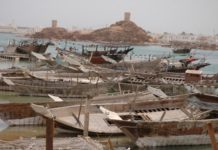Watercraft have been used in Australia for over 50,000 years. The first peoples travelled from Indonesian Islands by watercraft and established the Aboriginal culture and communities on the Australian continent. Bark canoes and rafts were the main vessels in use prior to European colonisation, while dugouts came with Macassan contact around 1500 to 1600 AD. The Torres Strait outriggers derived their background from the PNG examples and are also relatively recent. In the twenty-first century, a number of the traditional watercraft are still made by their community, and some have been adapted to more modern materials and methods of construction. Rex Greeno has produced replicas of the Tasmanian rolled bark canoes with traditional paperbark using modern glue as a binding agent. These canoes are in the collections of galleries and museums around Australia.
Wooden boat-building was an essential part of colonial settlement in Australia and continues to be popular for fishing and recreational craft with both professional and amateur builders. Restoration projects on older craft also maintain the skills and materials. Traditional clinker and carvel build methods have been adapted to local timbers . The techniques involved in wooden boatbuilding include steam bending timber, copper and bronze fastening and spar making. They use a full range of traditional tools including the adze, spokeshave, drawknife, hand planes, chisels, brace and bits.
Old growth eucalypt is a favoured material. Imported Oregon is widely used along with plantation grown hoop pine, the latter finding a place in local plywood production. The fine Tasmanian Huon and King William pines are no longer commercially harvested, but can be obtained by salvage in Tasmania’s west coast. Celery Top pine is commercially harvested in small quantities and is the most used timber for building boats in that state. Jarrah was a key timber in WA, and Queensland red cedar is another favoured wood for planking.
The craft is being taught in four year apprenticeships, 18-month diploma courses and shorter courses focused on specific vessels, such as a seven week course in clinker construction.
Tasmania has a strong living tradition of boat building. The Franklin Wooden Boat Centre has traineeships in traditional boat building that attracts participants from other countries. Hobart is also the site of the biannual Australian Wooden Boat Festival, which is the largest in the southern hemisphere. In Victoria, the couta boat was developed particularly to suit the conditions offshore in Bass Strait. These are still being made in Sorrento by Tim Phillips, and older craft have been restored. Williamstown is also a centre for wooden boat building at Blunts yard. In South Australia there is significant boatbuilding in and around Goolwa, including the Duck Flat Wooden Boats which have supported amateur building for over two decades. In New South Wales, the Pittwater Wooden Boats School in Sydney teaches traditional techniques. The National Maritime Museum provides an Australia-wide perspective on the craft with exhibitions and conferences and working on their own wooden craft. Croker Oars at Taree once practiced wooden oar making successfully, but these are now made with high-technology synthetic materials and exported worldwide.
Inland on the Murray River, there are shipwrights still working on the remaining wooden paddle steamers. In Queensland Peter Kerr at Sandgate is one of the main builders restoring wooden craft, while Fremantle has been a centre for wooden boat work in WA. Throughout the country there are many wooden boat projects underway and more planned.
This entry has been informed by the Australian National Maritime Museum and Rex Greeno.




